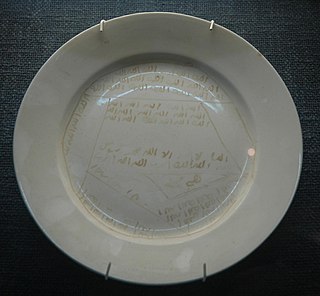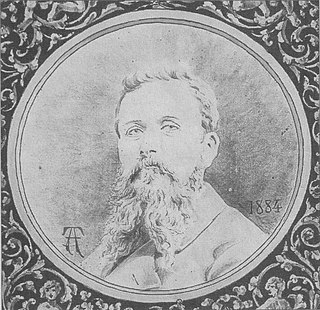| Location | Tripoli, Libya |
|---|---|
| Type | Epigraphy museum |
The Epigraphy Museum of Tripoli is a museum located in Tripoli, Libya. [1] [2] [3]

Sabratha, in the Zawiya District of Libya, was the westernmost of the ancient "three cities" of Roman Tripolis, alongside Oea and Leptis Magna. From 2001 to 2007 it was the capital of the former Sabratha wa Sorman District. It lies on the Mediterranean coast about 70 km (43 mi) west of modern Tripoli. The extant archaeological site was inscribed as a UNESCO World Heritage Site in 1982.
A Kenneth Hudson was a journalist, museologist, broadcaster and book author.

The Red Castle Museum, also known as As-saraya Al-hamra Museum, the Archaeological Museum of Tripoli or Jamahiriya Museum, is a national museum in Libya. It is located in the historic building known as the Red Castle of Tripoli, sometimes also referred to as Red Saraya, on the promontory above and adjacent to the old-town district with medina Ghadema.

The Corinthia Hotel Tripoli, originally known as the Corinthia Bab Africa Hotel, is a five star skyscraper hotel in Tripoli, Libya. It is located in the city center, near the central business district. It is run by the Maltese Corinthia Hotels International CHI plc hotels management company. The hotel was opened in 2003 by Prime Minister, Shukri Ghanem [More information required].
The Libyan Civil Aviation Authority is the civil aviation authority of Libya. Its head office is at Tripoli International Airport in Tripoli.
The Tripoli Central Hospital is a general hospital, located in Tripoli, Libya.

The Martyrs' Square ; known as Green Square under the Gaddafi government; Independence Square during the monarchy; and originally known as Piazza Italia is a downtown landmark at the bay in the city of Tripoli, Libya. The main commercial center of the city surrounds the square. The Square is also a main tourist attraction in Tripoli. It has a large legendary fountain done by an Italian architect at the centre of the square. The square is the meeting point of many different avenues. Omar Mukhtar Avenue is one of the longest in North Africa, it was built by Italians in the colonial time, and Libyans during the era of King Idris I. Independence Street branches from the square too, and it leads to the Palace of King Idris I. 24 December Avenue is also an Italian built avenue. Mizran Street is the last street that branches from the Martyrs' Square.

The National Archives of Libya is the national archives of Libya, located in the Red Castle in Tripoli. As of 1980 it was overseen by Salaheddin Hasan al-Suri, Director of Antiquities.

The Islamic Museum of Tripoli is a proposed museum of Islamic culture that was built under the support and patronage of Saif al-Islam Gaddafi in Tripoli, Libya.
The Ethnographic Museum of Tripoli is a museum located in Tripoli, Libya.
The Natural History Museum of Tripoli is a museum located in Tripoli, Libya. It was developed by Professor Zahid Baig Mirza.
The Prehistory Museum of Tripoli is a museum located in Tripoli, Libya.

The Museum of Libya is a museum located in Tripoli, Libya. It was originally built as the Royal Palace, completed in 1939. It was later used by King Idris during his reign. It then became known as the "People's Palace" after the fall of Ghaddafi.
The Janzur Museum is an archaeological museum located in Janzur, Libya. The museum showcases a funerary complex that is still under excavation by the Archaeology Department in Tripoli.

The Karamanly House Museum is a historic house and museum located in the Old city in Tripoli, Libya. It is associated with the Karamanli dynasty.

The State Museum of History of Uzbekistan, previously known as the National Museum of Turkestan, was founded in 1876. It is located in Tashkent.
The Mahdia Museum is a museum in Tunisia specialising in Tunisian archaeology and heritage. It is located in the city of Mahdia.

The Red Castle, in Arabic As-saraya Al-hamra, sometimes also Red Fort or Red Saraya, is a major landmark on the waterfront of Tripoli, bordering Martyrs' Square. It has been the home of the Red Castle Museum since 1919, and of the Libyan Department of Archaeology since 1952.

Adrien Thibault was a French ceramicist and historian. He was one of Ulysse Bernard's disciples in Blois, then he entered the Faïencerie de Gien by 1872. In 1874, he established his own workshop in La Chaussée-Saint-Victor, where he worked until his death. During his life, he conducted research on colors, and created so-called "Thibault Blues". The Adrien Thibault museum is located in La Chaussée-Saint-Victor, Loir-et-Cher.